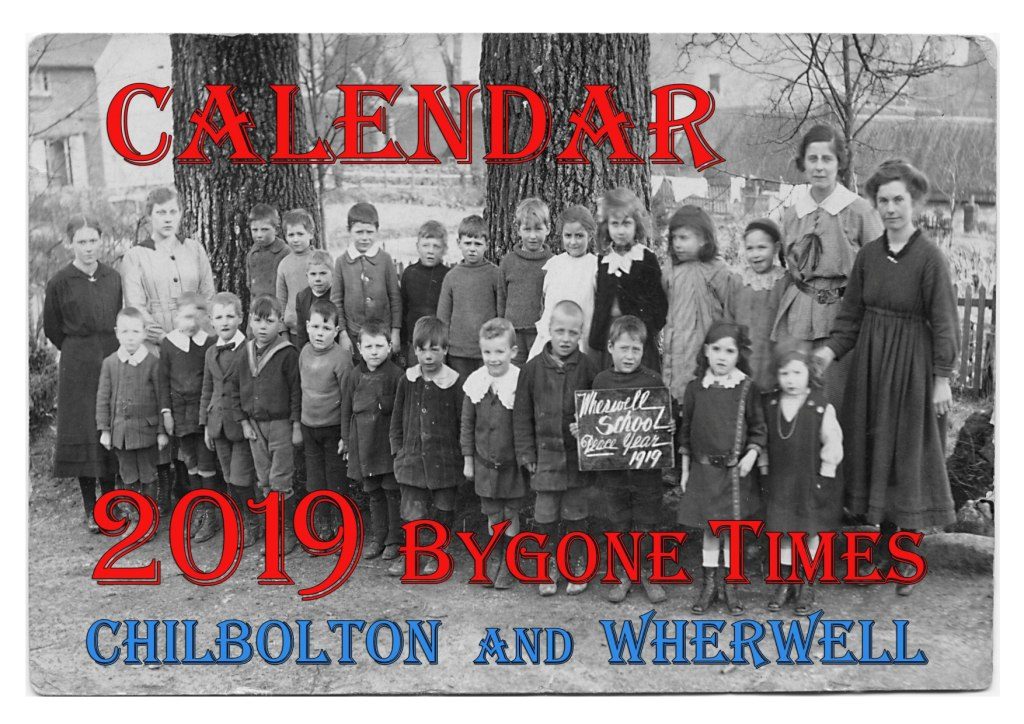
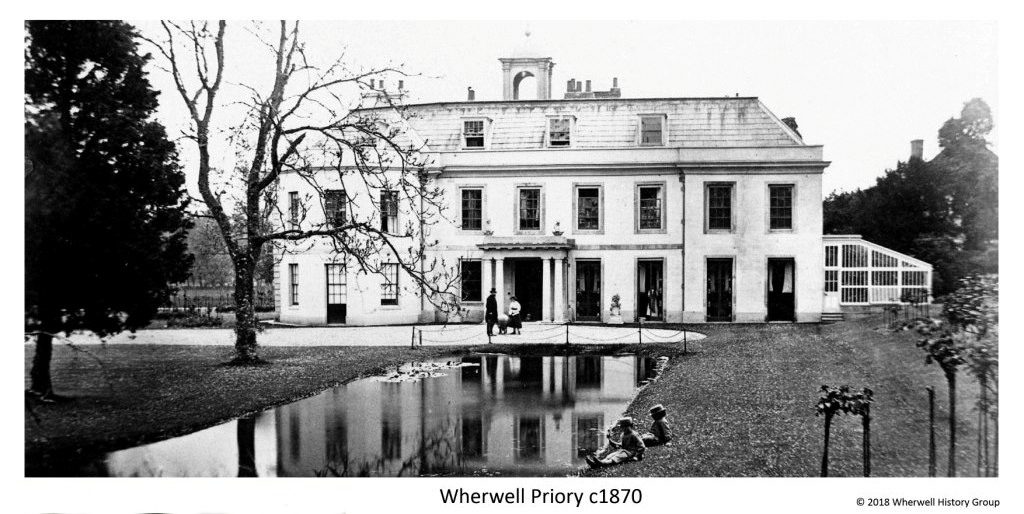 | Wherwell Priory Externally, Wherwell Priory appears to be early Georgian in style, but it was actually built in two different periods. The central block’ is believed to have been built in the mid C17th Carolean era. The north facing Georgian wing, with Tuscan style porch and shapely white cupola on the roof, was added later. Externally, the Priory portrays its familiar white facade, but is actually built of brick throughout with patches of flint in minor walls. The Priory is built on the site of Wherwell Abbey, founded by Queen Elfrida in 986, demolished by King Henry VIII in 1649 and traded to Lord De La Warr in exchange for five Manors in Sussex. The oldest building on the Estate is the stable block behind the Priory. With its banded flint and brick and some chalk blocks, it is believed to have been the mid C13th Abbey Infirmary. The Wherwell Priory Estate was owned by the Iremonger family and rented to tenants until bought by Sir Ernest Cassel in 1914, whence it passed to Colonel and Mrs Jenkins (niece) and then to their daughter Marjorie, Countess of Brecknock. |
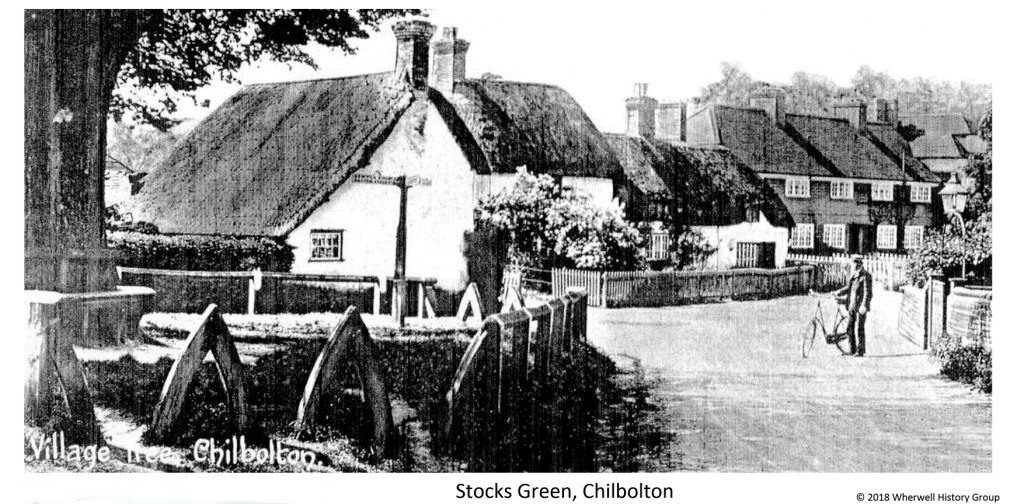 | Stocks Green, Chilbolton Chilbolton has four village greens; Stocks, Grindstone (adjacent the telephone box), Old Pond (midway between Cart Lane and the Abbots Mitre) and Coronation Tree (Coley Lane). Stocks (or 3 Ways) Green is the triangle where three roads meet outside the Church and where the village stocks stood from 1405-1837. Here, also, grew the traditional look-out tree from where observers could see down the valley. An elm was planted in 1824, to celebrate the 21st birthday of Richard Durnford (1802 1895), son of Rev. Richard & Louisa Durnford, who later to become Bishop of Chichester. The present tree (Prunus Sargentii) was planted circa 1995. Behind the sign-post is Lilac Cottage, which together with Heather Cottage and Spring Cottage was originally part of a much larger Chilbolton Cottage a C17th lime-washed thatched cottage with exposed timbers, once known as Goater’s Farmhouse. To the right is Whiteways (early C18th) and Room Cottages, a terrace of six houses in a Queen Anne style; built in 1893 with later additions and alterations attributed to W D Caroe. |
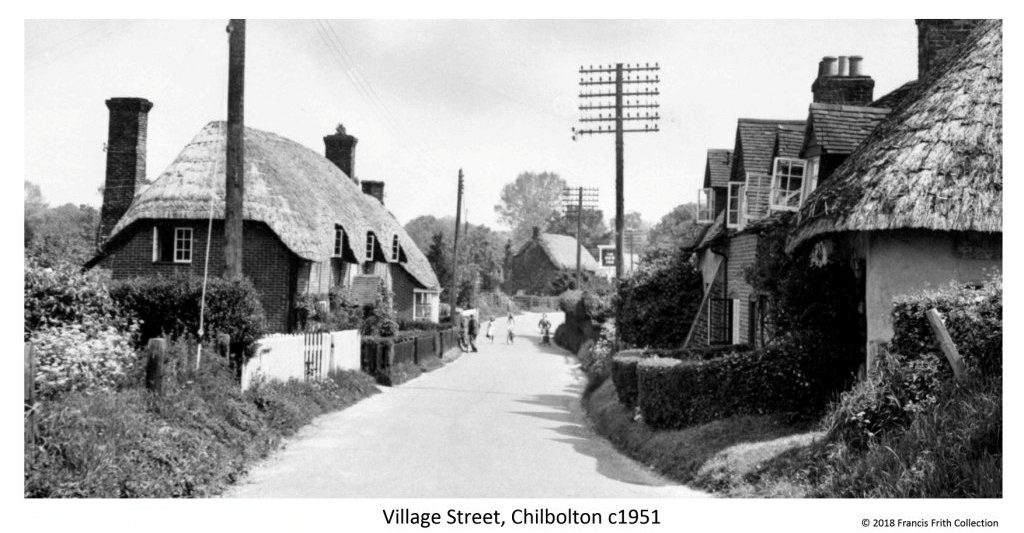 | Village Street, Chilbolton On the left foreground is Horseshoe Cottage and the right foreground is Upcote Cottage, both built in the late C17th as a pair of thatched cottages. Tom Baverstock, the last village blacksmith, lived all his life in the olde-world cottage with the horseshoe over the door. The Baverstock family were renowned for using wafering irons, thought to be over 300 years old and passed down through the family for generations. These irons, or tongs, have circular flat ends embossed with designs which create impressions on each side of a wafer cake, a flat biscuit, as it cooked. One disc is embossed with the letters I.S. from the Latin Iesus Salvator – Jesus the Saviour. The other disc has a central 8-pointed flower. The circular tracery patterns on the two discs are coincident; when light shines through a wafer, the circles on one side of the wafer are in the same place as those on the other side. Mothering Sunday is the fourth Sunday in Lent, when it was customary for domestic servants to visit their mother and family and take wafer cakes as presents. |
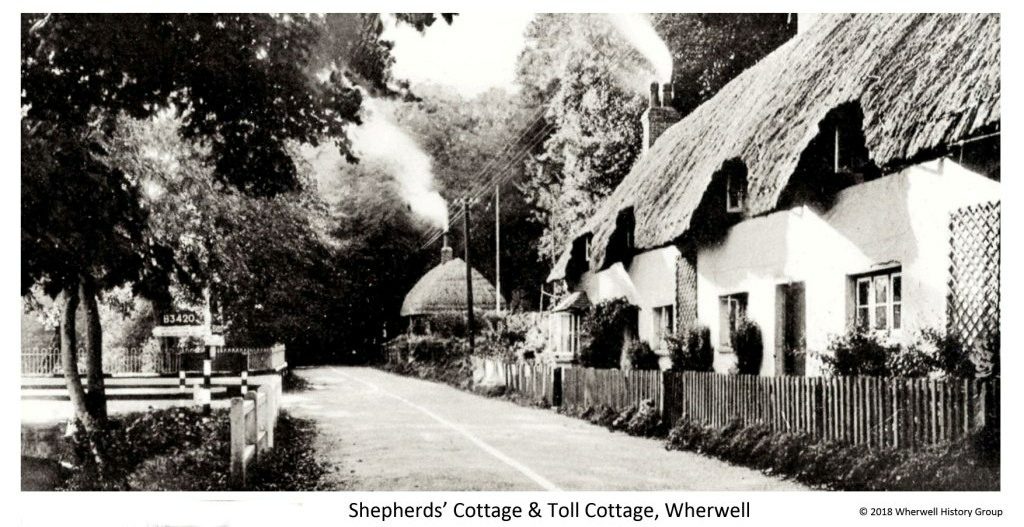 | Shepherds’ Cottage & Toll Cottage, Wherwell Shepherds’ Cottage was originally two dwellings with five bedrooms and two staircases, and was converted into a single cottage c1975. Many village families have lived here. In the 1930s, Mr & Mrs Parker with two sons; in the 1940s Nan West, the village midwife, with three daughters and brother Sam Elkins; in the 1950s Jim Halford, who married one of Nan’s daughters; in the 1960s Ernie and Rita Rowles lived next door to Ted and Rose Nutley. Shepherds’ Cottage, now owned for over 24 years by Audrey Hansford, a well-known local artist, is famed for its superb display of roses and has appeared on the cover of Country Life magazine. Toll Cottage is an early C19th brick and chalk stone cottage, with brick quoins, thatched roof, rendered walls and a small amount of flint-work. It was renovated in the late C20th. It is situated on the Andover to Winchester turnpike, which opened in 1762 and ran from Andover to Three Maids Hill, where it joined up with the Newbury to Winchester turnpike. |
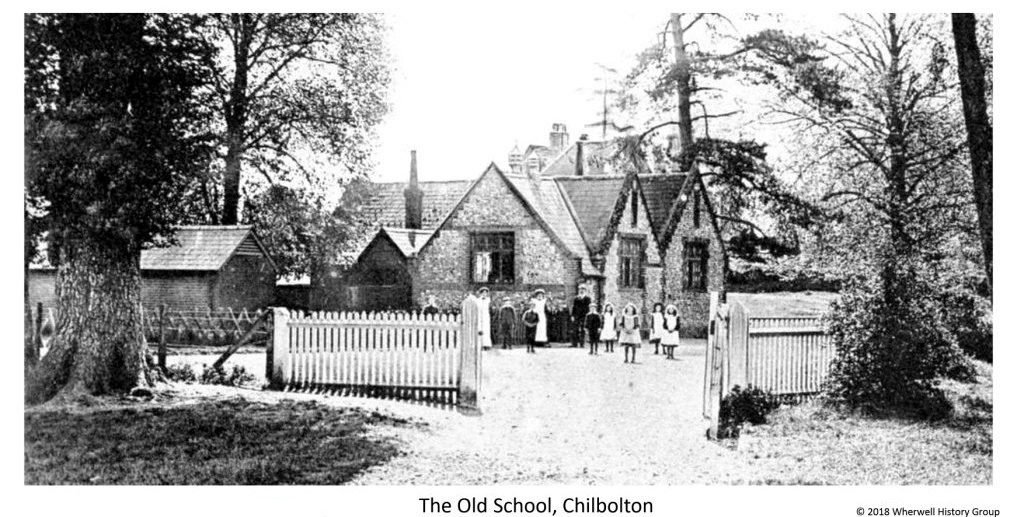 | The Old School, Chilbolton This flint and brick building was opened as the village school on 26th November 1843. It was enlarged in 1872, an extra room was added in 1878 and it was enlarged again in 1894. The first village school in Wherwell was housed up the Old Hill until 1928, when it moved to new premises in Longparish Road. Both village schools were merged in 1931. The first known teacher was Miss Harriet Knight. When George William Duckett became Headmaster in 1891, pupils began to practise writing on paper instead of taking slates to school. Mr. Duckett rendered 54 years service to the village as schoolmaster, officer for Hampshire Friendly Society, newspaper correspondent, overseer, Peoples Warden, Secretary to the Parochial Church Council and Clerk to the Parish Council. He loved to sing Gilbert and Sullivan and was also Church organist. Chilbolton Men’s Club was formed in 1925 and held their meetings at the (Old) Village Hall near Stocks Green. In 1933, funds to purchase a Billiards Table were raised from ten members and the Club moved to the Old School. After the Club closed, this building was still used as a Billiards Room until 2005. It was re-roofed in 2016. |
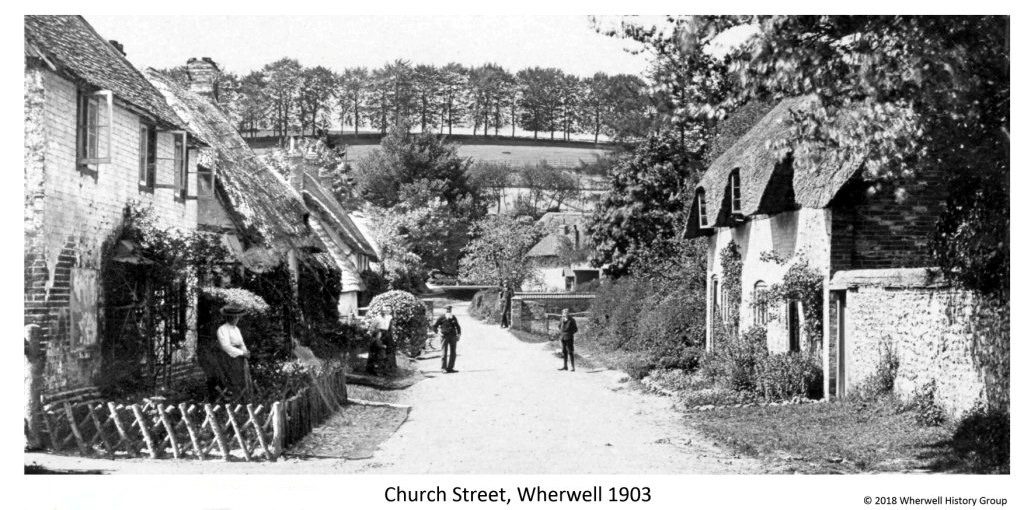 | Church Street, Wherwell Wherwell was an estate’ village – most people were either employed by the Priory, as servants, grooms, gardeners, in the dairy or on the land, or in trades that were use by the Priory and the village grocer, laundry, carter, coal merchant, midwife and undertaker, etc. Houses in the village had unique numbers, but were often named after an important occupant Goddard, Heather, Rodway for example. The house on the left, no. 27 (Goddards), is a late C18th house with unpainted brick walls in Flemish bond, flush 1st floor header band and stepped plinth. No. 28, also on the left, is one of the oldest cottages in Wherwell being C15th with some early C19th features and C20th rear extension. It comprises a late-medieval timber-framed structure of 3 bays, with a wider central bay, a C16th chimney inserted and a C17th stack built onto the south end. It has a thatched roof, whipped, with eyebrow to a dormer, irregular fenestration, exposed frame with filling of plaster and painted brickwork. Opposite are 25 (Antler) & 26 (Apple) a pair of C18th cottages, with C16th timbers, which were recently restored after a thatch fire in 2013. |
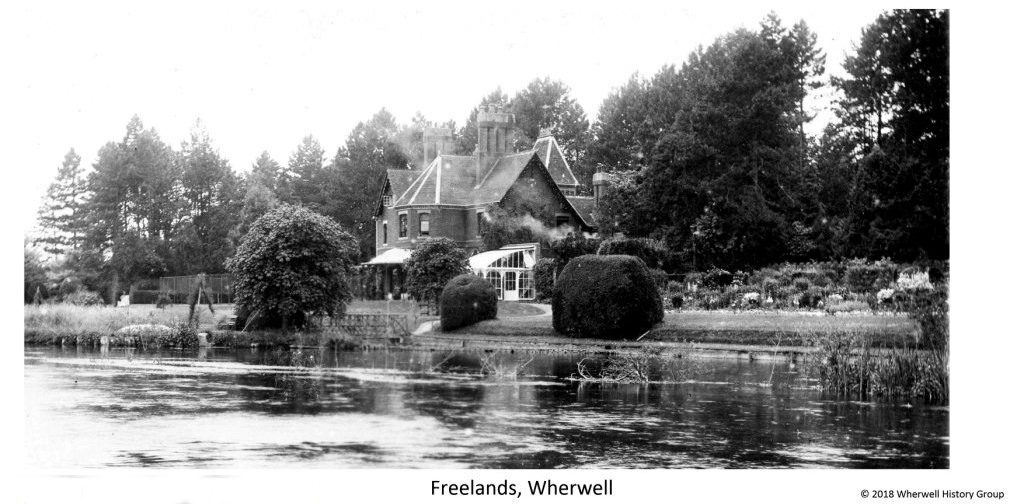 | Freelands, Wherwell The Freelands Estate was formerly several pieces and parcels of meadow or pasture owned variously by Richard Stanbrook, Richard Holdway, Sarah Fisher and William Iremonger. Freelands House was built in 1878 and ownership passed to the Hon. Kenelm Pleydell-Bouverie in 1889. In Country Life (1949) Freelands was described as a pleasantly situated country residence sitting in attractive grounds with ½ mile trout fishing, six bedrooms, four reception rooms, two bathrooms, convenient offices, mains electricity, excellent water supply, stabling and garage with rooms over, boathouse, orchard, paddock, rough grazing and woodland, five cottages, in all 32 acres. It was purchased by Anthony William Tuke (1897 – 1975) whose family lived there for over 65 years until 2017. Sir Anthony Favill Tuke (1920 – 2001) joined Barclays Bank in 1946, after serving in the Scots Guards for six years and rising to the rank of major. He was a Chairman of Barclays, like his father and grand-father, until stepping down in 1979. Emilia Mila married Sir Anthony in 1946 and passed away in November 2011, aged 88. |
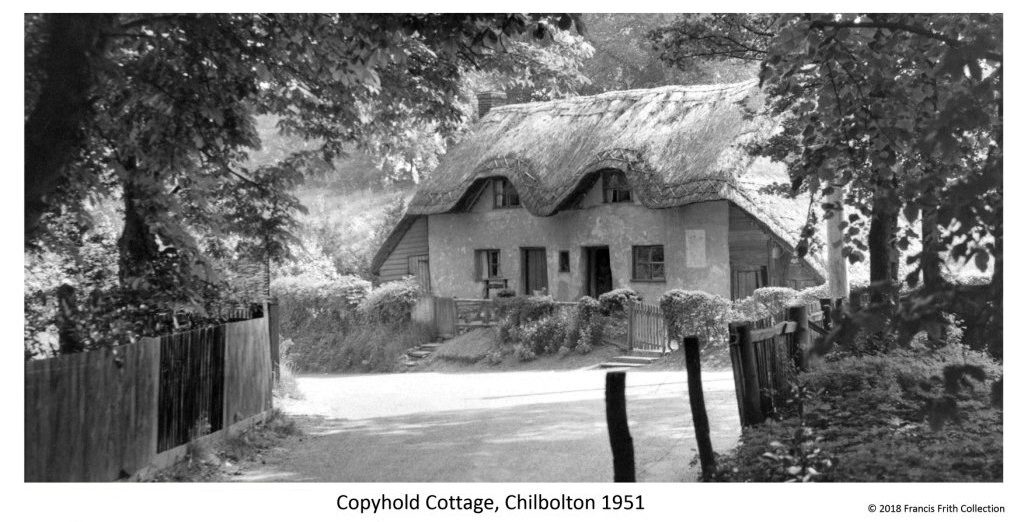 | Copyhold Cottage, Chilbolton The mid C19th Tithe Maps recorded tenure of land as freehold, leasehold or copyhold (ie: leased manorial land). Thus, copyholders were tenants of the lord of the manor, not the real landowner. Chilbolton is well known in law for two trials where owners of property formerly copyhold, but now freehold, sought to establish fishing rights on the river Test. In 1890, the trial of George Tilbury v. Edward Silva occupied the greater part of four days. In 1913, the trial of Henry Barrett Payne v. The Ecclesiastical Commissioners and Landon lasted a full five days. In both cases, the plaintiff’s case failed and was dismissed with costs. Copyhold cottage was originally a pair of thatched cottages and known as Fisher’s Cottage, where Thomas and Mary Fisher lived and whose son, Private William Fisher, died in 1915 aged 21 and who is commemorated at the Loos Memorial in France. Sir Varyl Cargill Begg DSO (1908 1995), a Lord Commissioner of the Admiralty, First Sea Lord and Governor of Gibraltar lived at Bannuts and then Copyhold. |
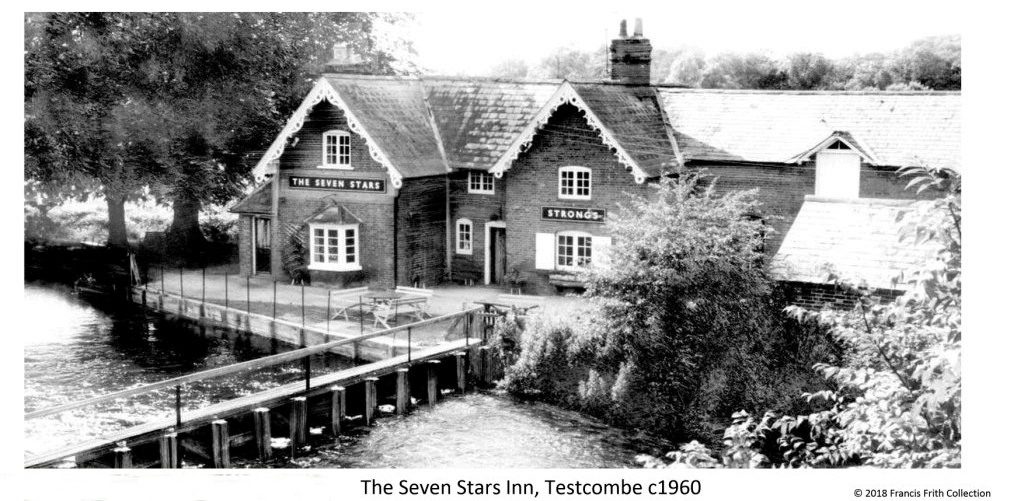 | The Seven Stars Inn Thomas Strong leased (1858) and then purchased (1875) a brewery at The Horse Fair, Romsey, together with 23 licensed houses. When Thomas Strong died in 1886, his executors sold the business to David Faber. Strong & Co of Romsey Ltd was registered as a company in 1894, and progressively acquired breweries and licensed and tied houses in Hampshire and neighbouring counties. In 1955 Strong & Co became an associated company of the Whitbread Group, leading to a complete takeover in 1968 and cessation of brewing at Romsey in 1981. The Gibbons Brewery (Weyhill), including the Seven Stars Inn, was definitely part of Strong & Co. in 1888 and may have survived as late as 1926. Inn Keepers at the Seven Stars were George Fifield (1851), William Fifield (1861), Jacob Neville (1871 & 1881), William Webb (1891 & 1901) and George Hayes (1911). The Inn became The Mayfly’ in the late 1970s with Julie Tuckett its publican until 1986. It became a managed Fullers house when Barry and Julie Lane retired in 2018. |
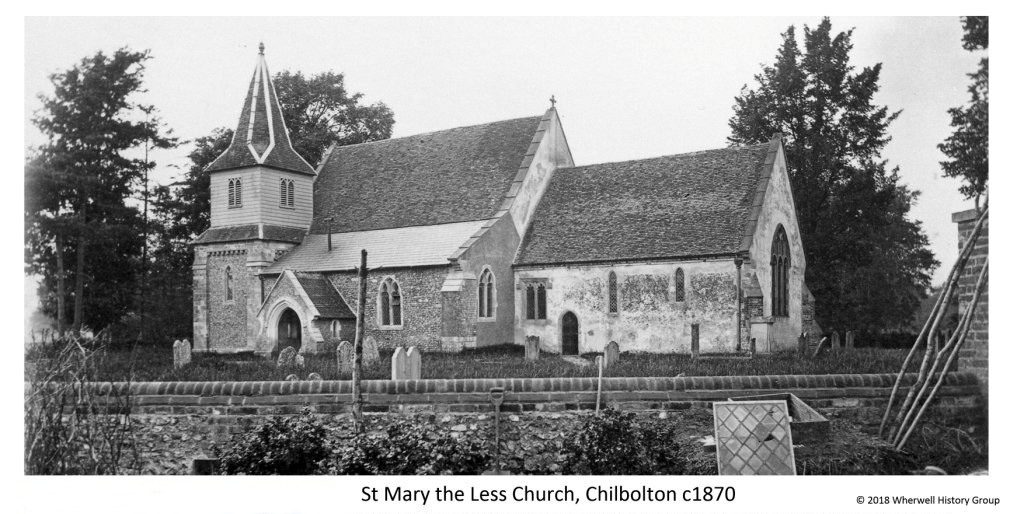 | St Mary the Less, Chilbolton A church at Chilbolton was mentioned in the Domesday Book of 1086. The “ecclesiam de Chylbalton ” was among property granted to the Hospital of St. Cross by its founder, Henry of Blois, Bishop of Winchester in 1132, and mentioned on the foundation charter. Richard I confirmed Chilbolton church to St. Cross in a charter dated 16th September, 1189. The chancel was almost entirely rebuilt in the first quarter of the 13th century. The nave preserves its 12th century length and width and much walling of that date. The aisles were added to the nave in the 14th century. The first recorded rector was Robert Bucknell on 10th May, 1284, under John de Pontesana, Bishop of Winchester. Dr Charles Layfield (b. 1649) was Rector from 1699 until his death in 1715. His Will bequeathed a Trust such that the income was applied to fund a school in Chilbolton with the residue distributed amongst the poor a duty now performed by the Parish Council. Chilbolton was transferred from Biddlesgate to Wherwell Hundred circa 1835. The Rev. Canon H. L. Marsh was Rector of Chilbolton when the two parishes were united into one on 12th July 1943, due to the retirement of the Vicar of Wherwell, the Rev. Alfred Lewis. The present day church has a peal of three bells, the oldest (treble) is inscribed 1641. |
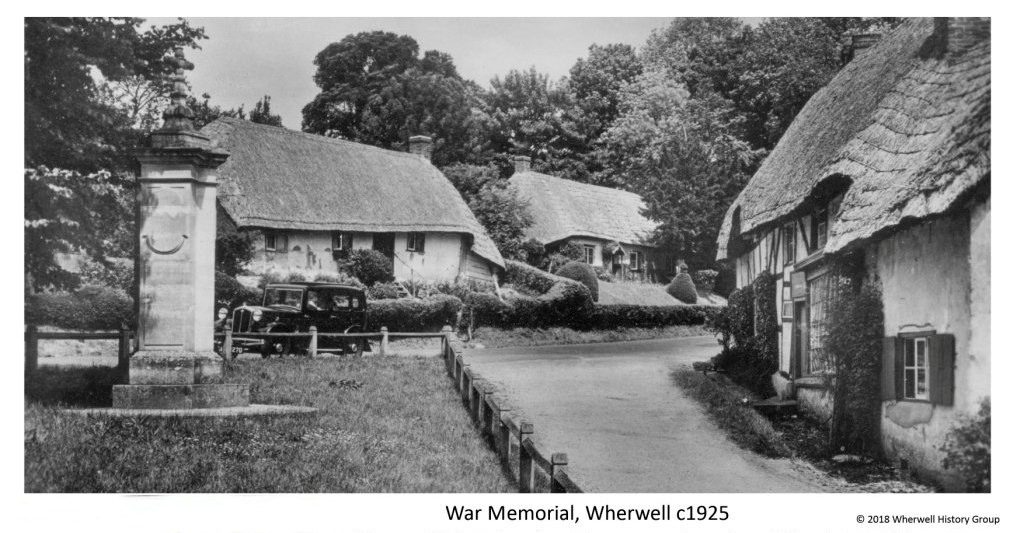 | The War Memorial, Wherwell This memorial statue is in the form of a metal cross surmounting a column of Chilmark stone with three piers jutting out from the centre on which the inscriptions appear. Two faces of the memorial commemorate the men who served in World War 1 and the third face commemorates those who died in World War 1 and World War 2. The memorial was unveiled by Major General Sir Robert Wigham and dedicated by local clergymen and dignitaries on 19th September 1920. On the triangle of land where the memorial stands, there have been three Pound’ trees. The first was a very large, old elm tree with a hollow trunk, which local children climbed inside. The second was a flowering cherry, reportedly donated by brothers Peter & Vincent Reiss in the mid 1950s. The third, another cherry, was felled in 2014. The curved cottage on the right side has been used for a mixture of trades – butchers, crockery and finally a shoe shop. |
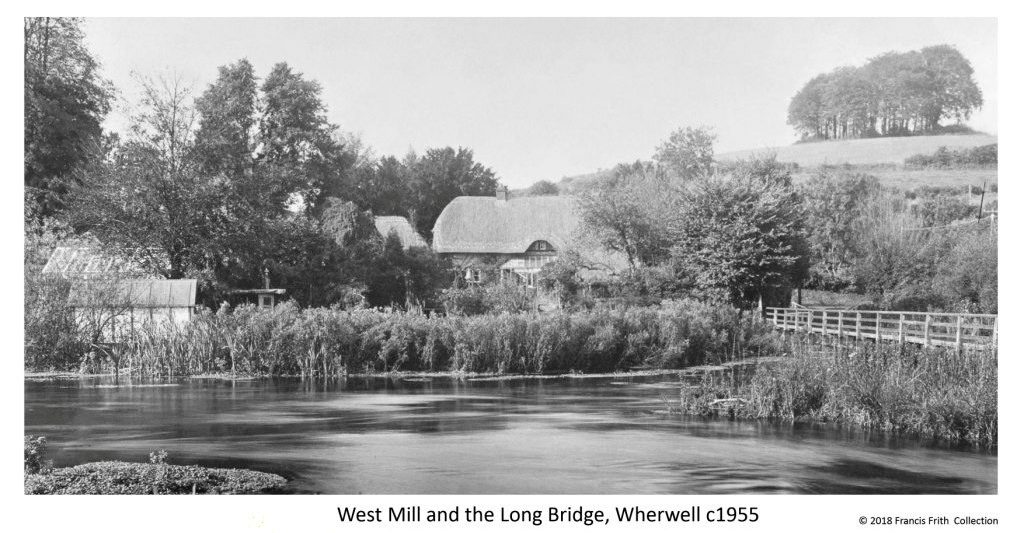 | West Mill & the Long Bridge, Wherwell At the time of the Domesday Survey, there were three water mills in Wherwell, worth 27s. 6d. Nothing remains of West Mill but the other two, East Mill (in Mill Lane) and Fullerton Mill, still boast their water wheels. West Mill cottage, built circa 1750, is a brick and flint house with thatched roof, timber-framed upper parts and both early and late C20th extensions. Previous owners include Elizabeth Coles (1844 Tithe Map) and Albert Spratt, local builder & carpenter (1870 Kelly’s). The Ford and the Drovers’ route to the east of the cottage were an important crossing of the river Test. Today’s Long Bridge has two side rails and hides the cable connecting Wherwell to the Telephone Exchange in Joys Lane, Chilbolton. If you are lucky, a flash of blue green announces the kingfisher; egrets, swans, ducks and the regal grey heron are all part of the vibrant river life here. But sadly, water voles Britain’s fastest declining mammal are no longer to be seen. |





No Comments
Add a comment about this page